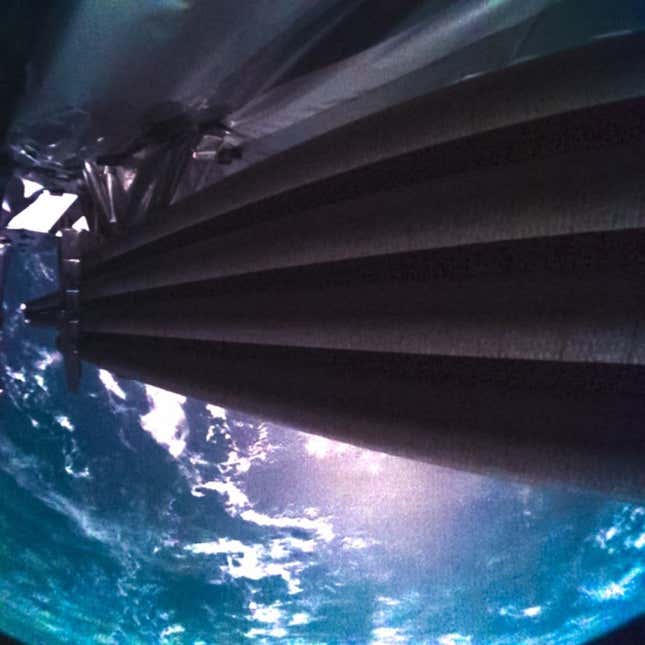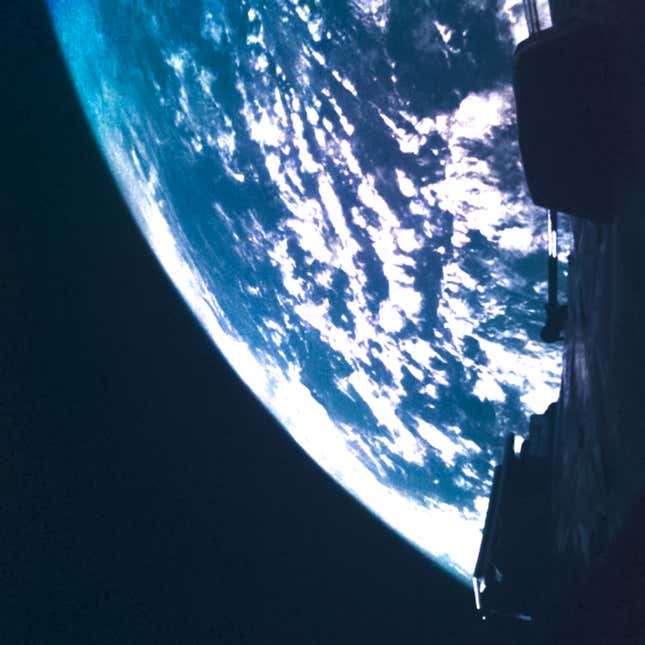JUICE Sends Farewell Photos of Earth as it Heads for Jupiter
Shortly after beginning its eight-year journey to Jupiter, the European Space Agency’s (ESA) JUICE mission posed with its home planet for some parting shots.
JUpiter ICy moons Explorer, or JUICE for short, captured its very first images just hours after launching on Friday, using Earth as a stellar background to test its monitoring cameras, ESA revealed on Saturday. The spacecraft also captured images of its solar array deployment, showing its shiny wings unfurling in the darkness of space.
ESA’s JUICE mission launched on April 14 at 8:14 a.m. ET from Europe’s Spaceport in French Guiana while tucked inside an Ariane-5 rocket. Just hours after liftoff, the spacecraft captured the first moments of its 12-year mission, dedicated to studying three of Jupiter’s icy moons: Europa, Ganymede, and Callisto.
In the images, parts of the spacecraft partially obstruct JUICE’s view of Earth. Before they were released over the weekend, however, the images were slightly processed and their colors adjusted.

The first batch of JUICE’s photos are nevertheless gorgeous, but this isn’t what we can expect from the mission’s views of Jupiter and its moons. JUICE’s first batch of photos were captured by its monitoring cameras—a pair of cameras designed to record the various developments with the mission. The monitoring cameras provide 1024 by 1024 pixel snapshots, while a scientific camera will eventually be used to take high-resolution images of the Jovian system in 2031.
The first monitoring camera is located on the front of the spacecraft, looking out onto JUICE’s solar arrays, while its second camera is on top of the spacecraft to monitor the deployment of the spacecraft’s 52-foot-long (16 meters) Radar for Icy Moons Exploration (RIME) antenna, according to ESA. The ice-penetrating radar, which will unfold in the coming days, will be used to probe the subsurface structures underneath the moons’ icy surfaces. Scientists suspect these moons of harboring liquid oceans beneath the surface, hence the interest from an astrobiological perspective.

JUICE’s first monitoring camera captured an integral part of the spacecraft’s journey: the deployment of its solar arrays. As seen in the image above, JUICE unfurled its massive solar array panels, which rotated into their 70-degree position to deploy the spacecraft’s silver wings.
The solar panels span across 915 square feet (85 square meters) in size, making it the largest array to ever be deployed for an interplanetary mission, according to ESA.
JUICE hasn’t said its final goodbyes to Earth just yet; the spacecraft will use the gravity of the Earth-Moon system to propel it on its trajectory through the inner solar system. So we will be seeing you again, JUICE.
For more spaceflight in your life, follow us on Twitter and bookmark Gizmodo’s dedicated Spaceflight page.
Shortly after beginning its eight-year journey to Jupiter, the European Space Agency’s (ESA) JUICE mission posed with its home planet for some parting shots.
JUpiter ICy moons Explorer, or JUICE for short, captured its very first images just hours after launching on Friday, using Earth as a stellar background to test its monitoring cameras, ESA revealed on Saturday. The spacecraft also captured images of its solar array deployment, showing its shiny wings unfurling in the darkness of space.

ESA’s JUICE mission launched on April 14 at 8:14 a.m. ET from Europe’s Spaceport in French Guiana while tucked inside an Ariane-5 rocket. Just hours after liftoff, the spacecraft captured the first moments of its 12-year mission, dedicated to studying three of Jupiter’s icy moons: Europa, Ganymede, and Callisto.
In the images, parts of the spacecraft partially obstruct JUICE’s view of Earth. Before they were released over the weekend, however, the images were slightly processed and their colors adjusted.

The first batch of JUICE’s photos are nevertheless gorgeous, but this isn’t what we can expect from the mission’s views of Jupiter and its moons. JUICE’s first batch of photos were captured by its monitoring cameras—a pair of cameras designed to record the various developments with the mission. The monitoring cameras provide 1024 by 1024 pixel snapshots, while a scientific camera will eventually be used to take high-resolution images of the Jovian system in 2031.
The first monitoring camera is located on the front of the spacecraft, looking out onto JUICE’s solar arrays, while its second camera is on top of the spacecraft to monitor the deployment of the spacecraft’s 52-foot-long (16 meters) Radar for Icy Moons Exploration (RIME) antenna, according to ESA. The ice-penetrating radar, which will unfold in the coming days, will be used to probe the subsurface structures underneath the moons’ icy surfaces. Scientists suspect these moons of harboring liquid oceans beneath the surface, hence the interest from an astrobiological perspective.

JUICE’s first monitoring camera captured an integral part of the spacecraft’s journey: the deployment of its solar arrays. As seen in the image above, JUICE unfurled its massive solar array panels, which rotated into their 70-degree position to deploy the spacecraft’s silver wings.
The solar panels span across 915 square feet (85 square meters) in size, making it the largest array to ever be deployed for an interplanetary mission, according to ESA.
JUICE hasn’t said its final goodbyes to Earth just yet; the spacecraft will use the gravity of the Earth-Moon system to propel it on its trajectory through the inner solar system. So we will be seeing you again, JUICE.
For more spaceflight in your life, follow us on Twitter and bookmark Gizmodo’s dedicated Spaceflight page.
